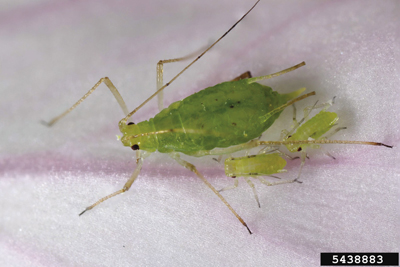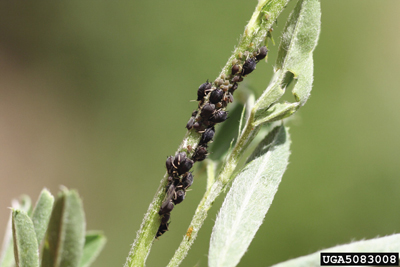Alfalfa Integrated Pest Management: Aphids
Guide A-339
J. Pierce
College of Agriculture, Consumer and Environmental Sciences New Mexico State University
Author: Extension Entomologist, Department of Extension Plant Sciences, New Mexico State University. (Print Friendly PDF)
Introduction
Aphids are small, soft-bodied insects that occur regularly in New Mexico alfalfa fields. They are often held in check by beneficial insects such as ladybugs. However, aphids can become an economic concern, causing plant stunting, delayed cuttings, or even some plant death in young stands. Aphids reproduce extremely rapidly because the females can produce offspring asexually. Therefore, regular field sampling is recommended to ensure that outbreak populations can be controlled before they cause economic losses. Using resistant varieties of alfalfa and maintaining high populations of beneficial insects are the best options to keep aphids in check.
To monitor aphids, sample four quadrants in each field. Randomly select five stems from each quadrant and record the stem height for each section. Shake the stems over a sweep net or white cloth and record the number and species of aphids collected. Total all quadrants and calculate the average per stem to determine if insecticidal control is justified.
Pea Aphid
The pea aphid (Acyrthosiphon pisum Harris) adults are bright green, long-legged, and about 1/8 inch long (Figure 1). They may be winged or wingless. Pea aphids usually cause the greatest damage in spring and early summer and then again in the fall.

Figure 1. Pea aphid adult and nymphs. (Joseph Berger, Bugwood.org)
Pea aphids congregate in dense colonies along the stems, terminal shoots, and leaves. Heavy infestations cause plants to wilt and turn yellowish green. Honeydew secreted by aphids is usually abundant on infested plants. Resistant varieties of alfalfa are very helpful in reducing pea aphid damage (Table 1).
Economic threshold: Insecticidal control is justified when counts in established alfalfa stands average 40—50 aphids per stem on plants less than 10 inches tall, or 70—80 aphids per stem on plants greater than 10 inches tall.
Table 1. Aphid Resistance Level of Selected Alfalfa Varieties*
|
|
Varietal Characteristics1 Pest Resistance | |||
| Variety | Propritor | Spotted Alfalfa Aphid | Pea Aphid | Blue Alfalfa Aphid |
| FSG 351 | Allied Seed | R | R | R |
| SG 351 | WL Research | R | HR | - |
| WL319HQPG1459 | Producer's Choic | - | R | - |
| WL343HQ | WL Research | - | HR | MR |
| FSG528SF | Allied Seed | - | R | - |
| 56S82 | Pioneer HiBred Int'l | HR | HR | HR |
| Cimarron VL600 | Great Plains Research | HR | HR | R |
| Wilson | New Mexico State University | MR | R | - |
| AmeriLeaf 721 | America's Alfalfa | HR | R | MR |
| Dona Ana | New Mexico State University | MR | R | - |
| 58N57 | Pioneer HiBred Int'l | R | HR | HR |
| Dura 843 | Croplan Genetics | HR | HR | HR |
| HybriForce-800 | Dairyland Seed Co. | - | MR | - |
| WL 550.RR | WL Research | R | HR | HR |
| 59N59 | Pioneer HiBred Int'l | HR | HR | R |
| WL 712 | WL Research | HR | HR | R |
| * Adapted from Lauriault, et al. (2011). |
| 1HR = high resistance, MR = moderate resistance, R = resistant |
Blue Alfalfa Aphid
The blue alfalfa aphid (Acyrthosiphon kondoi Shinji and Kondo) resembles the pea aphid, but is bluish green rather than yellowish to light green. Blue aphids congregate in clusters on the terminal growth, unlike pea aphids that may be found over the entire plant.
Blue alfalfa aphids tend to build high populations in early spring, with populations usually declining when temperatures reach over 85°F. Severe stunting and leaf yellowing can result from aphids feeding on new alfalfa regrowth less than 6 inches tall or when temperatures are below 75°F. Several semi-dormant and non-dormant alfalfa cultivars are resistant to blue alfalfa aphid (Table 1).

Figure 2. Cowpea aphids. (Whitney Cranshaw, Colorado State University, Bugwood.org)
Economic threshold: Insecticidal control is justified when 10—12 aphids per stem are found on regrowth in February through March. When alfalfa is more than half grown (stem lengths 10—15 inches long), the plant can tolerate 40 or more aphids per stem with little yield loss.
Spotted Alfalfa Aphid
The spotted alfalfa aphid (Therioaphis maculata Buckton) is a small, rapidly moving, pale yellow to gray aphid. It has four to six conspicuous rows of dark spots with small spines on the upper abdomen and smoky-veined wings.
This aphid is usually found on the undersides of lower leaves. However, as the population increases, aphids can be found on all parts of the plant. Spotted alfalfa aphids secrete large amounts of honeydew and will readily fall from alfalfa plants when disturbed.
Infestations can increase rapidly under favorable conditions. However, rain and high humidity often reduce infestations or create conditions unfavorable for survival.
Spotted alfalfa aphids can reproduce year-round in warm climates, but reproduction is inhibited at temperatures above 95°F or below 45°F. As many as 20 generations can be produced each year. The winged females may passively migrate more than 70 miles with the aid of winds.
Spotted alfalfa aphids secrete and inject a toxin that causes considerable plant injury, and may even kill seedlings. In established stands, growth will be severely stunted where yellow or chlorotic areas appear on the leaves. Leaf veins frequently remain green.
Alfalfa varieties that are resistant to spotted alfalfa aphids offer considerable protection from yield and stand losses (Table 1). Insecticides are not commonly required for this pest.
Economic threshold: In seedling stands, insecticidal control is justified when one aphid per plant occurs. In established stands, control is justified when 30—40 aphids per stem are found in the spring.
Cowpea Aphid
The cowpea aphid (Aphis craccivora Koch) can cause significant losses in New Mexico and elsewhere and is more likely to require treatment than the other aphids. This small aphid is easy to distinguish because it is the only black aphid in alfalfa. The adult is a shiny black color, while immature aphids are grey (Figure 2). The legs and antennae are a whitish color.
Cowpea aphids inject a toxin that can stunt or even kill plants when populations are high. Early infestations are patchy, so spot treatments are a possibility if infestations are noted early.
There are currently no alfalfa varieties available that are resistant to cowpea aphid, but check the website http://www.alfalfa.org/pdf/2013%20NAFA%20Variety%20Leaflet.pdf, which is revised every year with the most recent information.
Economic threshold: Insecticidal control is justified when 10—12 aphids per stem are found on plants less than 10 inches tall. Taller plants can tolerate more damage, so treatment is not recommended unless there are 40—50 aphids per stem.
References
Lauriault, L., I. Ray, S. Thomas, C. Sutherland, J. Ashigh, F. Contreras-Govea, and M. Marsalis. 2011. Selecting alfalfa varieties for New Mexico [Circular 654]. Las Cruces: New Mexico State University Cooperative Extension Service.
National Alfalfa and Forage Alliance. 2013 Winter survival, fall dormancy & pest resistance ratings for alfalfa varieties [Online]. Available from https://www.alfalfa.org/pdf/2013%20NAFA%20Variety%20Leaflet.pdf

J. Breen Pierce is a research and Extension entomologist at the NMSU Agricultural Science Center in Artesia. Her program focuses on integrated pest management of insect pests of alfalfa, pecan, and cotton, including biological control of alfalfa weevil and pecan nut casebearer, development of economic thresholds, and variation in plant resistance.
To find more resources for your business, home, or family, visit the College of Agricultural, Consumer and Environmental Sciences on the World Wide Web at pubs.nmsu.edu
Contents of publications may be freely reproduced for educational purposes. All other rights reserved. For permission to use
publications for other purposes, contact pubs@nmsu.edu or the authors listed on the publication.
New Mexico State University is an equal opportunity/affirmative action employer and educator. NMSU and the U.S. Department of Agriculture cooperating.
Printed and electronically distributed September 2013 Las Cruces, NM


